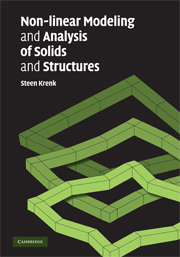Book contents
4 - Finite rotation beam theory
Published online by Cambridge University Press: 05 June 2012
Summary
Beams are slender structural elements, usually defined by their axis and cross-sections. This permits two basically different ways of modeling beams, one based on the translation and rotation of the points on the beam axis and the connected cross-sections (Fig. 4.1), the other treating the beam as a special example of a fully three-dimensional continuum. This chapter and the next develop fully non-linear beam models of the first type. In this chapter the fully non-linear theory of a beam represented as a curve with elastic properties – a so-called elastica – is developed, and its finite element implementation discussed. This theory is in principle unique, and can therefore be called the theory of the elastica. It describes the deformation of an elastic space curve in terms of total translation and rotation, and relies heavily on the properties of finite rotations, presented in Chapter 3. An alternative formulation of non-linear beams is presented in Chapter 5. In that description the motion is decomposed into a local deformation described in a frame of reference following the beam, and a motion of the local frame of reference. The local frame of reference moves with each beam element, and this type of formulation is therefore often called co-rotating. Simple beam theories can be used within a co-rotating formulation, where finite rotation contributions are added. The application-oriented reader may want to go directly to the co-rotational formulation in Chapter 5.
Information
- Type
- Chapter
- Information
- Publisher: Cambridge University PressPrint publication year: 2009
